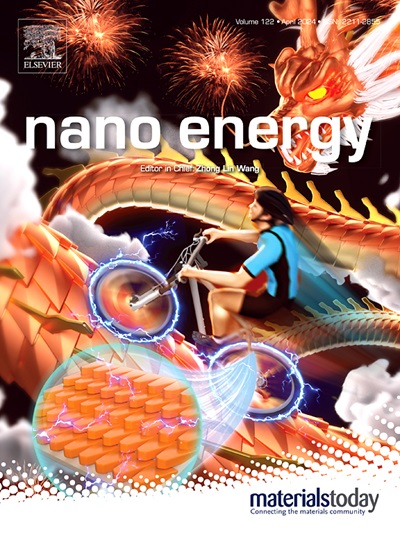Synaptic metaplasticity and associative learning in low-power neuromorphic computing using W-diffused BaTiO₃ memristors
IF 16.8
1区 材料科学
Q1 CHEMISTRY, PHYSICAL
引用次数: 0
Abstract
This study investigates polycrystalline tungsten (W)-diffused barium titanate (BaTiO₃) memristors, which demonstrate remarkable enhancements in both electrical and neuromorphic performance. Compared to their pure BaTiO₃ counterparts, the W-diffused memristors exhibit reduced forming, set, and reset voltages, thereby enabling energy-efficient operation. The W-diffused BaTiO₃ memristors achieve stable cycle-to-cycle (C2C) endurance over 1200 DC switching cycles, with low power consumption (36.6 pJ for Set and 45.5 pJ for Reset) and robust non-volatile retention exceeding 10⁴ seconds. These devices also support multilevel switching, controlled through precise modulation of current compliance (ICC) and reset-stop voltages within the range of ![]() 1 V to
1 V to ![]() 1.6 V. In addition to their electrical characteristics, the devices exhibit essential neuromorphic features, including long-term potentiation (LTP) and long-term depression (LTD), modulated by pulse parameters such as pulse number (50/50, to 110/110), width (10 µs to 50 µs), and amplitude. Core biological synaptic functionalities such as paired-pulse facilitation (PPF), post-tetanic potentiation (PTP), spike-voltage-dependent plasticity (SVDP), spike-number-dependent plasticity (SNDP), and synaptic metaplasticity were successfully emulated. A multibit neuromorphic system was experimentally realized using an incremental step pulse with verify algorithm (ISPVA), achieving stable 4-bit to 6-bit conductance states for high-density in-memory computing. Furthermore, the memristors exhibited nociceptive responses, enabling simulation of biological pain signals, and demonstrated Pavlovian associative learning behavior. Synaptic weight updates from the W-diffused BaTiO₃ memristors were implemented in a convolutional neural network (CNN) for CIFAR-10 image classification, achieving 91.3 % accuracy—closely matching the 91.7 % software baseline under optimized training conditions. These findings establish W-diffused BaTiO₃ memristors as strong candidates for next-generation, energy-efficient neuromorphic computing systems.
1.6 V. In addition to their electrical characteristics, the devices exhibit essential neuromorphic features, including long-term potentiation (LTP) and long-term depression (LTD), modulated by pulse parameters such as pulse number (50/50, to 110/110), width (10 µs to 50 µs), and amplitude. Core biological synaptic functionalities such as paired-pulse facilitation (PPF), post-tetanic potentiation (PTP), spike-voltage-dependent plasticity (SVDP), spike-number-dependent plasticity (SNDP), and synaptic metaplasticity were successfully emulated. A multibit neuromorphic system was experimentally realized using an incremental step pulse with verify algorithm (ISPVA), achieving stable 4-bit to 6-bit conductance states for high-density in-memory computing. Furthermore, the memristors exhibited nociceptive responses, enabling simulation of biological pain signals, and demonstrated Pavlovian associative learning behavior. Synaptic weight updates from the W-diffused BaTiO₃ memristors were implemented in a convolutional neural network (CNN) for CIFAR-10 image classification, achieving 91.3 % accuracy—closely matching the 91.7 % software baseline under optimized training conditions. These findings establish W-diffused BaTiO₃ memristors as strong candidates for next-generation, energy-efficient neuromorphic computing systems.

基于w扩散BaTiO₃记忆电阻器的低功耗神经形态计算中的突触元可塑性和联想学习
这项研究研究了多晶钨(W)-扩散钛酸钡(BaTiO₃)忆阻器,它在电学和神经形态性能方面都表现出显著的增强。与纯BaTiO₃相比,w扩散记忆电阻器具有更低的形成、设置和复位电压,从而实现了节能操作。w扩散BaTiO₃记忆电阻器实现了超过1200个直流开关周期的稳定循环到循环(C2C)耐久性,具有低功耗(Set为36.6 pJ, Reset为45.5 pJ)和超过10⁴秒的稳健非易失性保持。这些器件还支持多电平开关,通过精确调制电流遵从性(ICC)和复位停止电压在1 V至1.6 V范围内进行控制。除了电特性外,该器件还具有基本的神经形态特征,包括长期增强(LTP)和长期抑制(LTD),可通过脉冲数(50/50至110/110)、宽度(10µs至50µs)和幅度等脉冲参数调制。成功地模拟了核心的生物突触功能,如成对脉冲促进(PPF)、强电后增强(PTP)、spike-voltage-dependent plasticity (SVDP)、spike-number-dependent plasticity (SNDP)和synaptic metplasticity。采用增量步进脉冲验证算法(ISPVA)实验实现了多比特神经形态系统,实现了稳定的4- 6位电导状态,可用于高密度内存计算。此外,记忆电阻器表现出伤害性反应,能够模拟生物疼痛信号,并表现出巴甫洛夫联想学习行为。在卷积神经网络(CNN)中实现了来自w扩散BaTiO₃记忆电导器的突触权值更新,用于CIFAR-10图像分类,准确率达到91.3%,与优化训练条件下91.7%的软件基线非常接近。这些发现表明,w扩散BaTiO₃记忆电阻器是下一代节能神经形态计算系统的有力候选者。
本文章由计算机程序翻译,如有差异,请以英文原文为准。
求助全文
约1分钟内获得全文
求助全文
来源期刊

Nano Energy
CHEMISTRY, PHYSICAL-NANOSCIENCE & NANOTECHNOLOGY
CiteScore
30.30
自引率
7.40%
发文量
1207
审稿时长
23 days
期刊介绍:
Nano Energy is a multidisciplinary, rapid-publication forum of original peer-reviewed contributions on the science and engineering of nanomaterials and nanodevices used in all forms of energy harvesting, conversion, storage, utilization and policy. Through its mixture of articles, reviews, communications, research news, and information on key developments, Nano Energy provides a comprehensive coverage of this exciting and dynamic field which joins nanoscience and nanotechnology with energy science. The journal is relevant to all those who are interested in nanomaterials solutions to the energy problem.
Nano Energy publishes original experimental and theoretical research on all aspects of energy-related research which utilizes nanomaterials and nanotechnology. Manuscripts of four types are considered: review articles which inform readers of the latest research and advances in energy science; rapid communications which feature exciting research breakthroughs in the field; full-length articles which report comprehensive research developments; and news and opinions which comment on topical issues or express views on the developments in related fields.
 求助内容:
求助内容: 应助结果提醒方式:
应助结果提醒方式:


